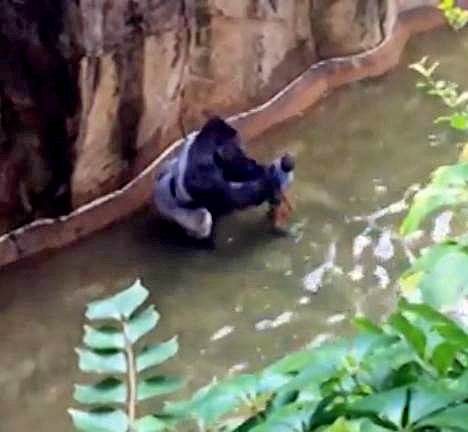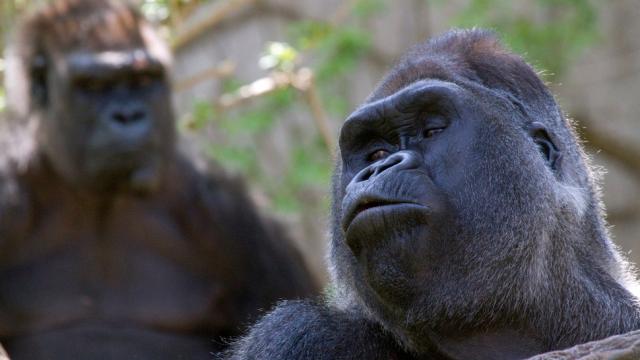The backlash has been vicious since zookeepers killed a gorilla named Harambe in order to protect a boy who fell into its enclosure at the Cincinnati Zoo. Now, police are investigating the parents in a misguided effort to administer blame, but one thing is more clear than ever: Zoos are awful places for animals to live, and zoos are awful places for humans to visit.
Image: Chris Miller/Flickr
Last weekend’s incident has a number of parties up in arms. The public is upset that the zoo shot a beloved 17-year-old Western lowland gorilla (a threatened species of which fewer than 175,000 still remain in the wild); the police are worried that the parents dared to take their eyes off a three-year-old for a split second; and activists are concerned that the zoo isn’t safe for animals or humans. In other words, people are pointing fingers in every direction.
There’s a strong case to be made that zoo officials made the right decision by killing the ape. After all, it wasn’t clear whether or not the gorilla would continue to harm the boy, and tranquillisers would have taken too long to sedate the animal. Critics say the gorilla was merely being protective and that the zoo acted rashly. But all this is beside the point. As this episode and others clearly show, zoos actually put animals in dangerous situations, and not the other way around.
Sadly, this happens all too often. As National Geographic points out, 42 animals have died during escapes or attacks in US zoos since 1990. During that time, 15 humans have been killed at zoos and 100 have been injured. Of these injuries, only 15 incidents involved primates. The last time a gorilla was fatally shot in a US zoo was in 2004, when 13-year-old Jabari was killed after escaping from the Dallas Zoo.
Zoos are terrible places for animals, even outside of tragic events like these. Aside from being confined to small spaces and the indignity of having to be gawked upon each and every day, zoo animals are regularly put down. The practice of “zoothanasia” was brought to the public’s attention in 2014 when four lions and a healthy young giraffe were put to death.
The idea that the public deserves to see animals like Harambe for purposes of education is also laughable. It’s highly unlikely that anyone learns anything by watching a gorilla who was born and raised in captivity, and who lived a life far outside its natural habitat and social context.
Another argument in favour of zoos is that they contribute to conservation and rewilding efforts. No doubt, programs like the Species Survival Plan (SSP) are meant to manage the breeding of endangered species to help maintain self-sustaining populations. The Association of Zoos and Aquariums currently runs more than 450 SSP Programs, including efforts to conserve and protect animals such as the giant panda, California condor and the lowland gorilla. Captive breeding programs have saved species from extinction — and that’s important to acknowledge — but that doesn’t mean these programs have to be conducted within the context of zoos. It’s important to point out that the vast majority of animals housed at zoos do not belong to threatened or endangered species, and many zoos are located in temperate areas, whereas most of the endangered species they hold tend to be tropical.
Despite the commendable goals of the AZA , most wildlife biologists consider such programs to be works in progress. These efforts will count for nothing so long as these animals are targeted by poachers and as their habitats continue to dwindle.

Image: YouTube
As noted, reaction to the latest episode involving a zoo animal has been swift. Animal rights activists recently held a vigil for Harambe at the zoo, and nearly 500,000 people have signed Change.org petitions in protest. Yesterday, Reuters reported that animal rights group Stop Animal Exploitation Now has decided to take matters a step further, filing a federal negligence complaint with the US Department of Agriculture. Should the Cincinnati Zoo be formally charged and convicted, it could face a penalty of up to $US10,000 ($13,845).
But the BBC reports that the police review of the incident is focused solely on “the actions of the parents/family that led up to the incident and not related to the operation or safety of the Cincinnati Zoo”.
Much of the public’s ire has been directed at the parents, too. Incredibly, over 400,000 people have signed this petition calling for the boy’s mother to be held accountable. Twitter user @blxxm83 wrote in a now deleted tweet, “So lazy parents can’t control their wild kids and a beautiful endangered animal gets shot and killed because of it? #Harambe #RIPHarambe.”
Others shared this sentiment:
sad thing is it looked like #Harambe was protecting the kid more than the parent was. #CincinnatiZoo
— brittany (@brittrosenthal) May 29, 2016
These reactions — as well as the criminal investigation of the parents — are as unfair as they are crazy. The fact that such a young child was able to climb the small wall and fall into the enclosure is testament to the fact that the physical barriers at the zoo are inadequate. By failing to prevent such an accident from happening, the zoo put both the child and the gorilla in danger.
What’s more, the Cincinnati Zoo already has a poor track record. The zoo was cited in 2016 for failing to close two doors that allowed a pair of polar bears to enter into a housing area. Both were tranquillised, but not before they did serious damage to cleaning equipment and electrical wires. Prior to that, the zoo was cited in 2014 for having deteriorating wood in horse and monkey enclosures.
So how do we prevent another incident like this from happening? Writing in Scientific American, animal rights advocate Marc Bekoff offered some sensible advice:
First, zoos need to stop breeding animals who are going to live in zoos for the rest of their lives. Zoos also should be turned into sanctuaries for the animals themselves. Over time there will be fewer and fewer captive animals and zoos as we know them can be phased out. And, the money that is saved as time goes on can be used to preserve populations of wild animals and their homes. These sorts of changes will take time and we need to be very patient, but we need to move in this direction.
Hopefully, this incident will start a broader discussion about zoos and the practice of putting great apes and other animals on display for human entertainment. Great apes, who are very closely related to humans, exhibit many cognitive and emotional traits deserving of personhood consideration (as do whales, dolphins and elephants, for that matter). Zoos are both cruel and, as this latest incident attests, dangerous to these animals.
In light of SeaWorld’s recent decision to phase out its orca whale population, perhaps zoos should take notice and do likewise with apes.
[Reuters]
